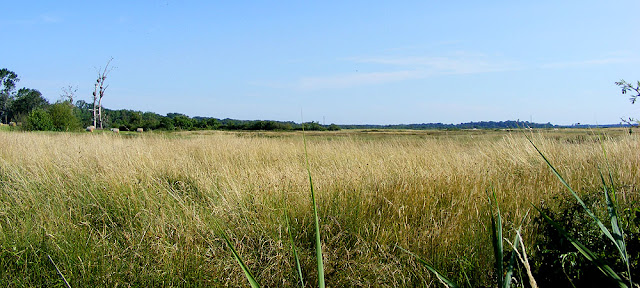The Brouage and Rochefort Esturine Marshes in Charente-Maritime are a paradise for herons, egrets, swans, storks and a hundred and fifty other species of birds.
 |
| Young storks on a manmade nest platform. |
The storks have been the subject of a conservation programme since 1978, with nesting platforms being erected and young birds being ringed.
 |
| Ringed adult stork. |
The marshes around Brouage and Rochefort offer a stopover and haven to waders, breeders and migratory birds of all sorts, with abundant invertebrates to feed them.
 |
| View of the marshes with the 'apartment block' on the left. |
Nowadays the storks in particular are a major attraction for the area.
 |
| A stork 'apartment tower' on the edge of the marsh, with lots of cormorants. |
Today Charente-Maritime has the largest population of White Stork Ciconia ciconia (Fr. Cigogne blanche) in France, with just over 500 breeding pairs producing around 900 chicks every year in various large salt marshes and estuaries along the coast. This is from a low point in the 1970s when the species had more or less disappeared from France. Numbers of storks here are now higher than in the species other French stronghold, Haut-Rhin (Alsace).
 |
| Me photographing and watching storks from the ramparts of the Brouage star fort. |
In the Brouage Marshes the storks are considered an umbrella species ie if they are protected, then the knock-on effect is protecting the whole ecosystem.
 |
| The Brouage marshes, with storks foraging. |
Just twelve years ago there were only six nests on the marsh itself, but some of the storks no longer bothered to migrate. The climate on the Brouage Marshes was so agreable that they simply stayed put, sedentary at the end of summer. Now there are ten times the number of nests and they are the only predator of an invasive non-native crayfish. Today about 80 individuals are resident all year round. These birds tend to get the best nest sites, being able to lay claim to them before the migrants arrive back in February at the beginning of the breeding season.
 |
| The storks taking advantage of the hay mowing disturbing insects in the grass. |
Food is abundant, especially the invasive alien crayfish Procambarus clarkii (Red Swamp Crayfish), and storks happily scoff all they can find, thus protecting amphibians and fish stocks by preventing their eggs from being eaten by the crayfish. Their crustacean diet has another benefit too, providing the storks with plenty of carotene for colouring their legs and beaks a good strong orangey red.
 |
| Adults foraging in newly cut hay on the marsh. |
One of the problems of managing nesting storks in the marsh is that they have a liking for electricity pylons as nest sites. Nowadays there is a joint programme between the electricity supplier and the bird conservationists to physically move inappropriately sited nests to new purpose built platforms, sometimes attached to the pylon the birds originally chose. Apparently the birds tolerate this very well. The bird conservationists also often take the opportunity to install a kestrel nest box under the big metal mesh wheel on a tall pole erected for the storks.
The storks will use the same platform for several years at least. Sometimes the nests will tumble off trees or even the purpose built poles in the winter. When this happens the conservationists make sure a new nest site is available nearby. A standard nest platform is made from a wooden pole inserted in a two metre deep hole and secured with wire cable stays. A metal ring with netting stretched over it is placed on top and several bundles of wood added for the storks to construct their nest from.
Males arrive back before females and claim a nest (sometimes before the conservationists have finished working on it). The eggs are laid in March and chicks hatch in 35 days. The young birds take off for southern climes from July and August, some of them having been ringed in June. Their parents will depart for Spain or Africa in September and October.
 |
| An adult foraging. |
The marsh is a maze of actively managed canals, winding narrow roads and cattle grazing.
 |
| An adult flies, close to the nest. |
Since the 1970s the storks have been ringed to help monitor them, and every year they are surveyed to count their numbers and distribution. In the last few years ringing has ceased, as the population is safe and stable. The conservationists are thus able to focus on other tasks with the time that has been freed up.
 |
| Adults, including a ringed one, foraging. |
The first scientific observation of migrating storks in Charente-Maritime was made in 1841. The oldest known stork from the area, according to her ring information, was a female of 26 years who died in 2018.
We are also on Instagram, so check us out to see a regularly updated selection of our very best photos.

6 comments:
I always thought that storks were a feature of only Alsace. I had no idea there were so many in South-West France.
Very interesting and informative post, as usual.
We had no idea until we went there this year either.
A great success story. We need all of those we can get. Thank you!
Yes, a big credit to the local stork conservation group.
They are being re-established in the UK as well, it seems:
https://www.nationalgeographic.com/animals/2020/07/white-storks-nesting-britain-after-six-centuries/
Yes, I heard that. Lovely.
Post a Comment